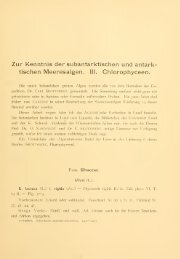Download PDF
Download PDF
Download PDF
You also want an ePaper? Increase the reach of your titles
YUMPU automatically turns print PDFs into web optimized ePapers that Google loves.
TAXONOMIC CHARACTERISTICS 7<br />
walls formed by the conjugating tube and the two gametangia.<br />
This conjugation apparatus is relatively persistent and the zygospore<br />
remains in the enclosure for days or weeks after its own<br />
walls are mature. Zygospores at first have two nuclei and either<br />
one set of chromatophores (Spirogyra) derived from the receptive<br />
gametangium, or two sets (Zygfjema and Mougeotia) derived<br />
from both gametangia, one of which disintegrates later. After the<br />
union of the nuclei, reduction division occurs and four nuclei<br />
result. Of these, three disintegrate and the remaining one becomes<br />
the nucleus of the basal cell of the sporeling on germination.<br />
Only when one contemplates the many successive steps in<br />
conjugation from the development of papillae and adhesion of<br />
the gametangia onward to the maturation of the spore walls and<br />
protoplast, does he realize how very complicated are the chemical,<br />
physical, and biological processes that are integrated in zygospore<br />
development (PI. I, Figs. 3, 8, 9, and 10).<br />
Parthenospores may be formed when the normal union of one<br />
gamete with another fails to occur either by absence of an opposite<br />
gamete, or by sudden changes in environmental conditions. In<br />
some collections gametes are numerous; in others, rare. Partheno-<br />
spores can usually be distinguished from aplanospores by their<br />
position in the gametangial cells and their relation to adjacent<br />
zygospores. It is customary to say that "they resemble the zygo-<br />
spores of the same species but are smaller." Akinetes, aplano-<br />
spores, zygospores, and parthenospores have all been seen germi-<br />
nating by numerous students. New filaments grow from any of<br />
these forms.<br />
The taxonomy of the Zygnemataceae has been centered on the<br />
conjugation apparatus: its development, forms, and zygospores.<br />
The evolutionary history of reproduction in the group, however,<br />
must have begun with propagation and survival by akinetes.<br />
These are frequently seen in other families of the Chlorophyta.<br />
The development of aplanospores must have been a next step in<br />
evolution. This is not a large step either, since it implies merely<br />
the contraction of the protoplast and the growth of a spore wall.<br />
This type of spore also occurs in many other families of the<br />
Chlorophyta.<br />
When aplanosporangia became differentiated chemically and<br />
hormones with plus and minus properties were released which<br />
brought about local growth of cell walls followed by adhesions




